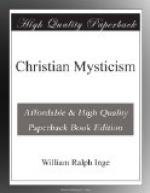[Footnote 82: Col. i. 26, ii. 2, iv. 3; Eph. iii. 2-9. I have allowed myself to quote from these Epistles because I am myself a believer in their genuineness. The Mysticism of St. Paul might be proved from the undisputed Epistles only, but we should then lose some of the most striking illustrations of it.]
[Footnote 83: Rom. vi. 4.]
[Footnote 84: Rom. viii. 11.]
[Footnote 85: St. Paul’s mystical language about death and resurrection has given rise to much controversy. On the one hand, we have writers like Matthew Arnold, who tell us that St. Paul unconsciously substitutes an ethical for a physical resurrection—an eternal life here and now for a future reward. On the other, we have writers like Kabisch (Eschatologie des Paulus), who argue that the apostle’s whole conception was materialistic, his idea of a “spiritual body” being that of a body composed of very fine atoms (like those of Lucretius’ “anima"), which inhabits the earthly body of the Christian like a kernel within its husk, and will one day (at the resurrection) slough off its muddy vesture of decay, and thenceforth exist in a form which can defy the ravages of time. Of the two views, Matthew Arnold’s is much the truer, even though it should be proved that St. Paul sometimes pictures the “spiritual body” in the way described. But the key to the problem, in St. Paul as in St. John, is that pyscho-physical theory which demands that the laws of the spiritual world shall have their analogous manifestations in the world of phenomena. Death must, somehow or other, be conquered in the visible as well as in the invisible sphere. The law of life through death must be deemed to pervade every phase of existence. And as a mere prolongation of physical life under the same conditions is impossible, and, moreover, would not fulfil the law in question, we are bound to have recourse to some such symbol as “spiritual body.” It will hardly be disputed that the Christian doctrine of the resurrection of the whole man has taken a far stronger hold of the religious consciousness of mankind than the Greek doctrine of the immortality of the soul, or that this doctrine is plainly taught by St. Paul. All attempts to turn his eschatology into a rationalistic (Arnold) or a materialistic (Kabisch) theory must therefore be decisively rejected.]
[Footnote 86: Col. iii. 1.]
[Footnote 87: Phil. ii. 6.]
[Footnote 88: Col. i. 15-17.]
[Footnote 89: Eph. i. 10.]
[Footnote 90: Col. iii. 11.]
[Footnote 91: 1 Cor. xv. 24-28.]
[Footnote 92: 1 Cor. x. 4.]
[Footnote 93: 1 Cor. xi. 7.]
[Footnote 94: Eph. iv. 13.]
[Footnote 95: Gal. ii. 20.]
[Footnote 96: Gal. iv. 19.]
[Footnote 97: 2 Cor. iii. 18.]
[Footnote 98: Rom. xii. 5.]
[Footnote 99: 1 Cor. xii. 25.]
[Footnote 100: 1 Cor. ii. 1, 2.]




